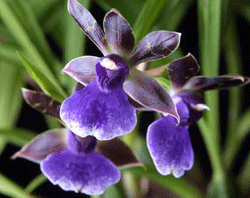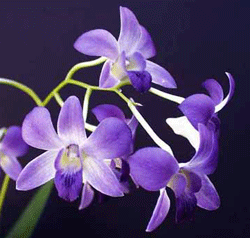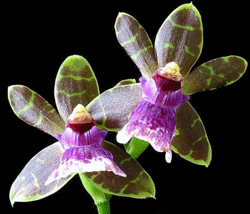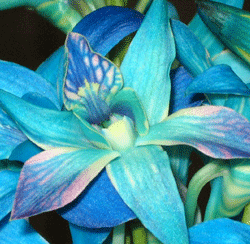|
  The
Orchidaceae family is the largest and most diverse
of the flowering plant families, with over 800 described
genera and 25,000 species. The
Orchidaceae family is the largest and most diverse
of the flowering plant families, with over 800 described
genera and 25,000 species.
There are another 100,000+ hybrids and cultivars
produced by horticulturists, created since the introduction
of tropical species in the 19th century. About 800
new species are added each year.
Orchids, through their interactions with pollinators
and their symbiosis with orchid mycorrhizal fungi,
are considered by some to be the most advanced known
examples of floral evolution.
  All
orchid species are protected under CITES as potentially
threatened or endangered in their natural habitat.
Many other species are protected by both international
and national legislation. All
orchid species are protected under CITES as potentially
threatened or endangered in their natural habitat.
Many other species are protected by both international
and national legislation.
The term 'orchid' derives from the Greek orchis,
meaning "testicle", from the appearance
of subterranean tuberoids of the genus Orchis. The
word "orchis" was first used by Theophrastos
(372/371 – 287/286 BC), in his book "De
historia plantarum" (The natural history
of plants). theophrastos was a student of Aristotle
and is considered the father of botany and ecology.
Orchids, like the grasses and the palms, which they
resemble in some ways are monocotyledons. They have
one cotyledon, or embryonic leaf, in contrast to the
two of most flowering plants. Orchids are widely distributed,
occurring in every habitat, except Antarctica and
in deserts. Most advanced orchids have five basic
features:
- The presence of a column, also called gynostemium
- Flowers are bilaterally symmetric (zygomorphic)
- Pollen are glued together into the pollinia, a
mass of waxy pollen on filaments.
- Seeds are microscopically small, lacking endosperm
(food reserves) in the overall majority of the species.
There are notable exceptions, such as Disa cardinalis,
whose seeds may grow to a length of 1.1 mm. Seeds
of Vanilla may weigh 20 times or more than that
of other orchids.
- Seeds can, under natural circumstances, germinate
only in symbiosis with specialised fungi.
  Orchids
have simple leaves with parallel veins. Their shape
is highly variable between species; ovate, lanceolate,
or orbiculate. Their size and shape can be an aid
in identifying the orchid, since it reflects the taxonomic
position. The leaves can be enormous or minute, or
they can even be lacking, as in the Ghost Orchid. Orchids
have simple leaves with parallel veins. Their shape
is highly variable between species; ovate, lanceolate,
or orbiculate. Their size and shape can be an aid
in identifying the orchid, since it reflects the taxonomic
position. The leaves can be enormous or minute, or
they can even be lacking, as in the Ghost Orchid.
The structure of the leaves corresponds to the specific
habitat of the orchid. Species that typically bask
in sunlight, or grow on sites which can be occasionally
very dry, have thick, leathery leaves. The laminas
are covered by a waxy cuticle. These retain their
necessary water supply. Shade species, on the other
hand, have tall, thin leaves. They cannot tolerate
a drop in atmospheric humidity or exposure to direct
sunlight. Between these two extremes, there is a whole
range of intermediate forms.
|
|
|
Orchids
in the Langudoc
|
Anacamptis fragrans
Anacamptis laxiflora
Anacamptis morio
Anacamptis palustris
Anacamptis papilionacea
Anacamptis picta
Anacamptis pyramidalis
Cephalanthera damasonium
Cephalanthera longifolia
Cephalanthera rubra
Dactylorhiza fuchsii
Dactylorhiza incarnata
Dactylorhiza maculata
Dactylorhiza majalis
Dactylorhiza occitanica
Dactylorhiza sambucina
Epipactis atrorubens
Epipactis helleborine
Epipactis microphylla
Epipactis muelleri
Epipactis palustris
Epipactis rhodanensis
Epipactis tremolsii
Gymnadenia conopsea
Himantoglossum hircinum
H. robertianum
Limodorum abortivum
Liparis loeselii
Listera ovata
Neotinea maculata
Neotinea tridentata
Neotinea ustulata
Neottia nidus-avis
Ophrys aegirtica
Ophrys apifera
Ophrys arachnitiformis
Ophrys araneola
Ophrys aurelia
Ophrys bilunulata
Ophrys ciliata
Ophrys drumana
Ophrys forestieri
Ophrys funerea
Ophrys incubacea
Ophrys insectifera
Ophrys lupercalis
Ophrys lutea
Ophrys massiliensis
Ophrys passionis
Ophrys provincialis
Ophrys pseudoscolopax
Ophrys scolopax
Ophrys splendida
Ophrys sulcata
Ophrys virescens
Orchis anthropophora
Orchis mascula
Orchis militaris
Orchis olbiensis
Orchis provincialis
Orchis purpurea
Orchis simia
Platanthera bifolia
Platanthera chlorantha
Serapias parviflora
Serapias vomeracea
Spiranthes aestivalis
Spiranthes spiralis
|
|
There are many types of specializations within the Orchidaceae.
Best known are the seemingly endless structural variations
in the flowers that encourage pollination by particular
species of insects, bats, or birds.
The typical orchid flower is. bilaterally symmetric. Notable
exceptions are the genera Mormodes, Ludisia and Macodes.
It is in the variety and the refinement of their reproductive
methods that orchids truly amaze. On many orchids, the lip
(labellum) serves as a landing pad for flying insects. The
labellum is sometimes adapted to have a color and shape
which attracts particular male insects via mimicry of a
receptive female insect. Some orchids are reliant solely
on this deception for pollination. After pollination, the
epigynous ovary starts developing and produces a many-seeded
capsule.

 The
Lady's Slipper (Paphiopedilum) has a deep pocket that traps
visiting insects, with just one exit. Passage through this
exit leads to pollinia being deposited on the insect.
The
Lady's Slipper (Paphiopedilum) has a deep pocket that traps
visiting insects, with just one exit. Passage through this
exit leads to pollinia being deposited on the insect.
Many neotropical orchids are pollinated by male orchid
bees, which visit the flowers to gather volatile chemicals
they require to synthesize pheromonal attractants. Each
type of orchid places the pollinia on a different body part
of a different species of bee, so as to enforce proper cross-pollination.
A Eurasian genus Ophrys has some species that look and
smell so much like female bumblebees that male bees flying
nearby are irresistibly drawn in and attempt to mate with
the flower, such as with the Bumblebee Orchid (Ophrys bombyliflora).
The viscidium, and thus pollinia, stick to the head or the
abdomen of the bumblebee. On visiting another orchid of
the same species, the bumblebee pollinates the sticky stigma
with the pollinia. The filaments of the pollinia have, during
transport, taken such position that the waxy pollen are
able to stick in the second orchid to the stigma, just below
the rostellum. Such is the refinement of the reproduction.
If the filaments had not taken the new position on the bee,
the pollinia could not have pollinated the original orchid.
Other species of Ophrys are mimics of different bees or
wasps, and are also pollinated by males attempting to mate
with the flowers, and other orchid genera practice similar
deception.
An underground orchid in Australia, Rhizanthella slateri,
never sees the light of day, but depends on ants and other
terrestrial insects to pollinate it.

 The
orchid ovary is always located behind the flower. If pollination
was successful, the sepals and petals fade and wilt but
they remain attached to the ovary. The epigynous ovary typically
develops into a capsule that is dehiscent by 3 or 6 longitudinal
slits, while remaining closed at both ends. The ripening
of a capsule can take 2–18 months. The microscopic
seeds are very numerous (over a million per capsule in most
species). They blow off after ripening like dust particles
or spores, barely visible to the human eye. Since they lack
endosperm, they must enter symbiotic relationship with mycorrhizal
fungi to germinate. These fungi provide the necesary nutrients
to the seeds.
The
orchid ovary is always located behind the flower. If pollination
was successful, the sepals and petals fade and wilt but
they remain attached to the ovary. The epigynous ovary typically
develops into a capsule that is dehiscent by 3 or 6 longitudinal
slits, while remaining closed at both ends. The ripening
of a capsule can take 2–18 months. The microscopic
seeds are very numerous (over a million per capsule in most
species). They blow off after ripening like dust particles
or spores, barely visible to the human eye. Since they lack
endosperm, they must enter symbiotic relationship with mycorrhizal
fungi to germinate. These fungi provide the necesary nutrients
to the seeds.
Vanilla , is one of the rare examples of orchids used for
food. Vanilla seeds and their surrounding pulp within the
seed pod are used in the food industry to make the extremely
popular flavouring "vanilla extract".

